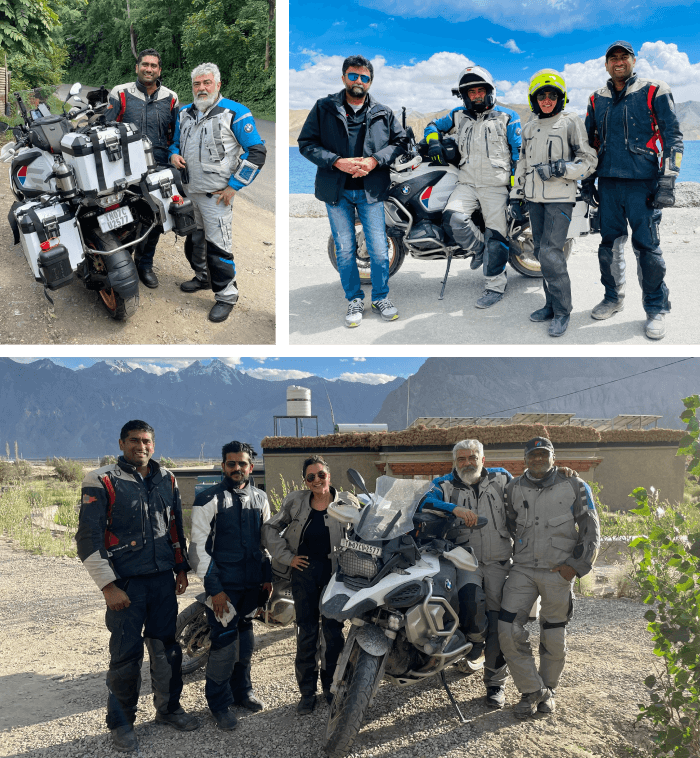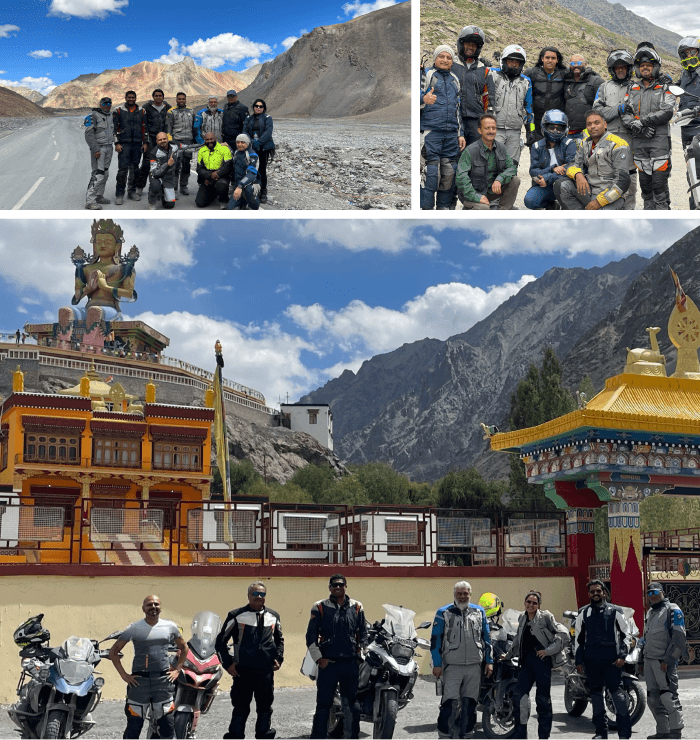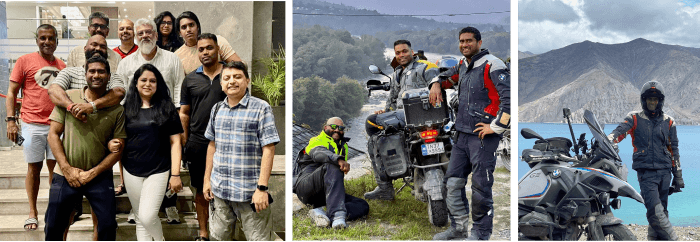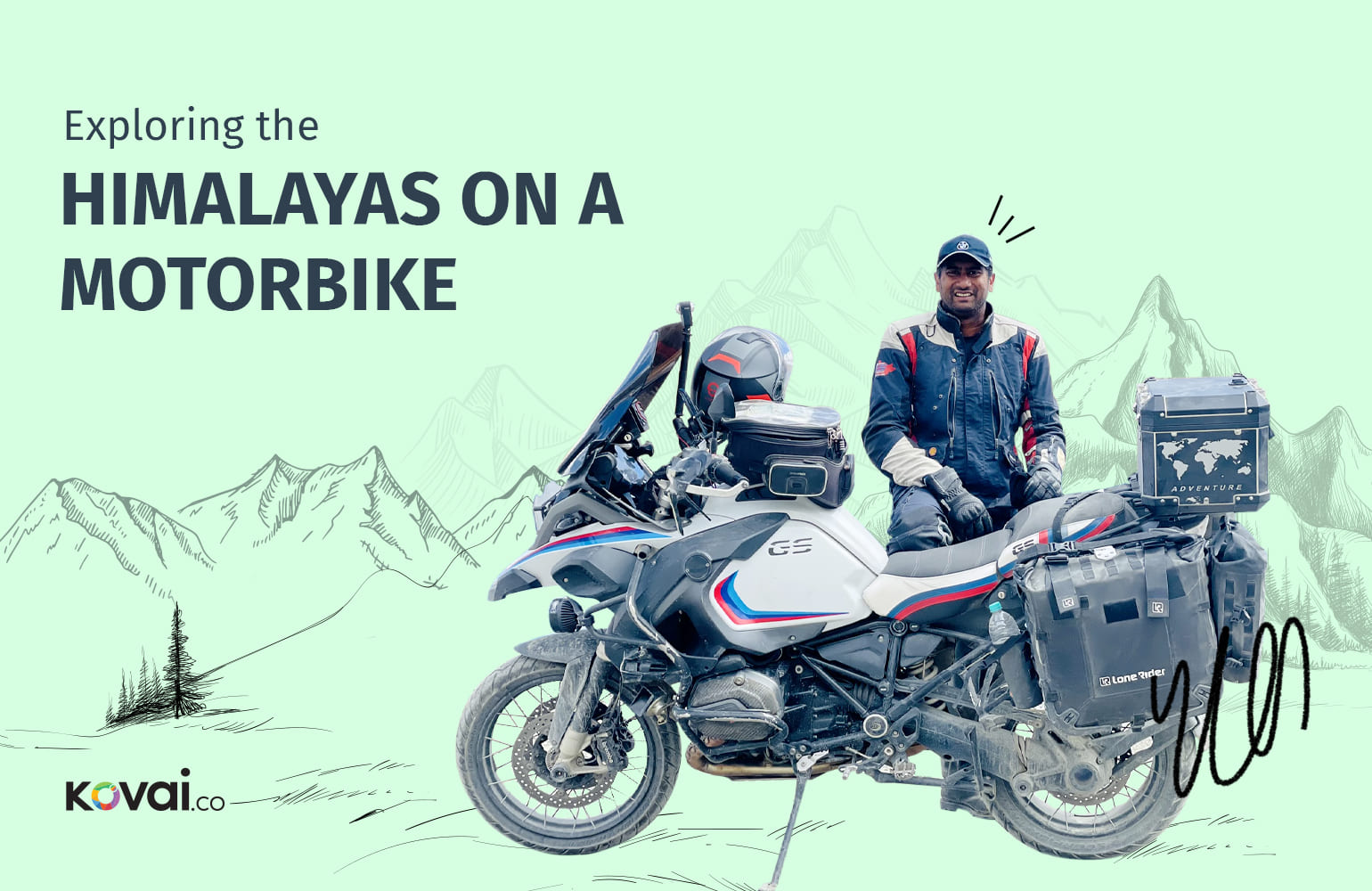Introduction
Director of Churn360, Suprej Venkat, recently led a group of 10 bikers on a 15-day bike trip through the Leh Ladakh region. Leh is known as the crown jewel of all rides as far as motorcycle enthusiasts are concerned, primarily because of its rugged terrain, broken roads, and high altitudes. The route includes riding across Khardung la pass, which at 18,380 ft is the world’s highest motorable road. In fact, it is at an even higher altitude than Everest Base Camp.
Suprej talks to us about his experiences riding across some of the toughest, most dangerous terrains at an altitude of more than 13,800 ft above sea level. His experience also includes leading a group of riders who come from across age groups, riding experiences, and backgrounds.

Planning the trip
A self-confessed adventure enthusiast and adrenalin junkie, Suprej Venkat, who has either driven or ridden across 40 countries, including a 35-day ride from South Africa to Kenya, had begun planning a Leh Ladakh ride in 2019-end.
“But there is a saying that goes, you can’t go to the Himalayas when you want. The Himalayas has to call you,” says Suprej.
“As part of the Adventure Riders group, we had even drawn a route map. But the pandemic came in 2020. It got pushed to 2021 when the second wave hit us again,” says Suprej. Bike trips in Ladakh can only be done during four months of the year—June to September.
Taking the initiative to again plan the trip afresh, Suprej, got in touch with a local guide to understand the terrain. He followed it up with research on good places to stay, routes to take, complications that could come up, etc. “Planning a road trip route is one of my favorite pastimes. So, I first planned the route and schedule, including rest or buffer days every three days. I also listed out places to see and things to do,” he says.
In a few weeks, Suprej had a detailed day-to-day itinerary on an excel sheet. Details included the number of kilometers, hours they were going to ride each day, things to do, people joining them, accommodation, costs, who had paid and who hadn’t, permit requirements, etc.
“It may seem extensive. But this detailed planning helps other riders feel more confident about the trip and ride itself to go off smoothly,”.
Preparation
Since a large portion of the trip involved riding in extremely dusty conditions, riders were all asked to send their vehicles for an oil service and change air filters etc.
“We also asked all riders to carry their own toolkits and get enough experience to fix their own punctures,” says Suprej.
Riders were also asked to plan their fuel requirements based on the distance because there were long stretches and locations where there were no fuelling stations.
The beginning
The group landed in Chandigarh on August 26 and unpacked their bikes which had arrived by trucks. The next day they began their trip with an 8–9-hour ride to Manali. They then went on to ride to Jispa and from there to Sarchu. It was on day 3 at Sarchu, which was 13,779 ft above sea level when altitude sickness hit them for the first time.
“People began suffering from headaches and a few even began throwing up. Even after taking the required medicines to handle acclimatization, people were suffering from a lack of appetite. People were also shivering due to the heavy winds. Added to that, only tent accommodation is available at Sarchu so we all struggled,” he says.
The team then began their ride to Leh. They got to ride through Lachulungla Pass which is at 16,600 ft and Tanglangla pass at 17,480 ft above sea level, which are some of the world’s highest motorable roads.
“The initial few days were not easy. For example, the roads between Chandigarh and Manali were bad and full of traffic. Later, we had to deal with altitude sickness. But none of us ever thought of turning back or dropping out”.

Riding through Leh and Kashmir
The group reached Leh on August 31, on day 6 of their trip. After spending a relaxed evening walking around local markets, they spent the next day acclimatizing and sightseeing around Leh. They spent the next three days riding around Ladakh region which included the Pangong Tso Lake, Tso Moriri Lake, famous Khardungla Pass, Nubra Valley, and Shanti Stupa.
“The whole region was simply stunning. Like on one side of the Atal tunnel you will find green valleys with grown tall trees but soon on the other end, you find just barren desert,” says Suprej. You start feeling extremely humbled by nature which shows you multiple faces all within the span of a day or a few hours, he adds.
The group then went on to ride to Kargil, Srinagar, Jammu, and then back to Chandigarh, where they took a flight out.
Management lessons from the trip
#1 Bringing people together for a common purpose
People on the ride were from extremely diverse backgrounds, for example, we had film actors, businessmen, bureaucrats, and working professionals. We had to get them to come together for a common purpose, a common vision, and we all were motivated to complete the Ladakh trip on 2 wheels.
Having said that, I believe the camaraderie you feel with other riders on a bike trip, especially one such as a ride through Leh, is second to none. Because we are all a bit crazy. It is an extremely hard, dangerous ride but we still did it. The emotional bonding you feel with a fellow rider who rides by your side and supports you is mind-blowing.
#2 You are only as fast as your slowest rider
Sometimes going on a large group ride is like managing a team. You may have riders with different bikes, different speeds, riding skills, and experience. But you don’t ride as per the speed of your fastest rider. You can’t leave anyone behind, so your whole group is only as fast as your slowest rider.
That’s exactly how it is while managing a team. You have people with different capacities and skills, but a good leader takes everyone forward together. You do that by understanding everyone’s strengths and weaknesses, helping those who need it to push forward.
#3 Taking decisions as a group
After reaching Pangong Tso, we were all debating whether we were going to ride further to Tso Moriri Lake the next day or return to Leh. None of us knew how tough the ride was going to be or what we were going to see in Tso Moriri. While some felt, we had come this far and should not miss an opportunity to check out Tso Moriri, a few others felt it would be more of the same terrain, scenery preferring to go back to Leh.
So how did we resolve the difference? We sat around discussed pros and cons. Judging the group’s collective mood, we decided that we would go to Tso Moriri next morning.
Honestly, the ride was hard because initially, it was just dust and gravel, but the second half had some beautiful water crossings. We were all extremely exhausted once we reached, but we were left with amazing memories since the ride was a sheer adventure and it made us all better riders.

#4 Returned fully recharged to conquer our goals
Take that time and effort to do something you are truly passionate about. Though our 15-day trip was physically tiring, we all returned extremely recharged to work because we truly enjoyed ourselves. When you spend so many days out there enjoying nature’s beauty, feeling vulnerable on a motorcycle, it leaves you humbled. It gives you purpose and often helps in taking that extra step or pushing forward.
#5 Our difficulties are minuscule
The road and tunnel construction by Border Roads Organisation in such harsh terrain & altitudes is mind-blowing. There are so many road works happening that in a few years riding through Ladakh, will be no different from riding through the alps. Just the sheer amount of work they are doing is awe-inspiring and makes you so proud of having a military like ours.
To think that they spend months and years working in harsh regions that we struggle to spend just a few days in is humbling. We ride in these regions confidently because the armed forces keep our borders safe. Seeing them brave these harsh weather conditions leaving their families behind for months together and working so hard, suddenly makes us feel like we have no real difficulties at all. Anything is solvable, achievable, and manageable.
Conclusion
Identify your dream adventure or break and take that leap of faith. You will come back recharged and motivated because you know how amazing life is.

